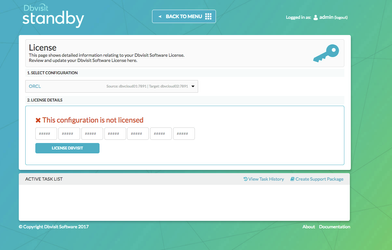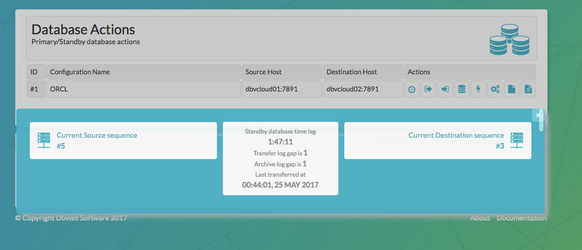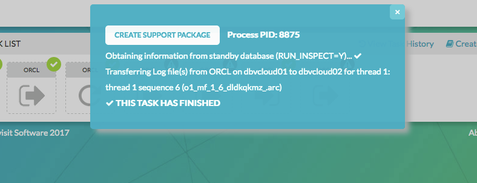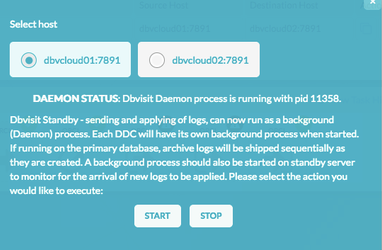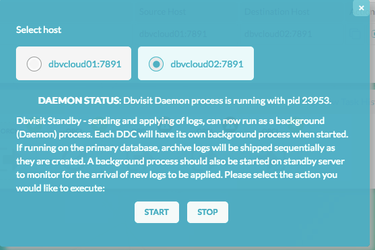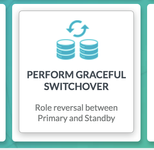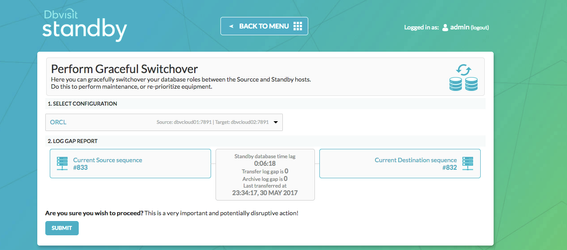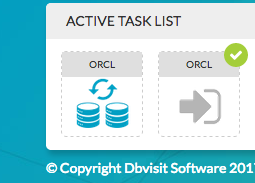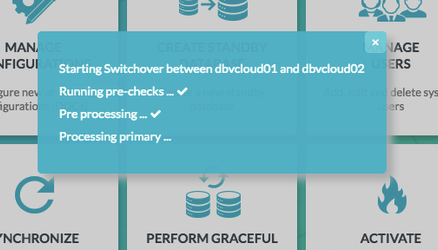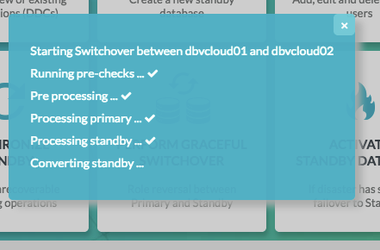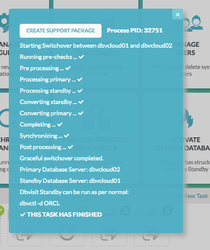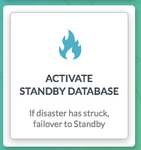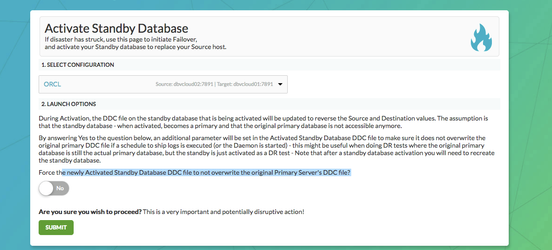| Table of Contents |
|---|
1. Introduction
The purpose of this Deployment guide is to demonstrate the way in which Dbvisit Standby 8.0 software can be used within the Oracle Database As A Service (DBaaS) space. In this guide, we focus on both the Primary and Standby databases hosted on DBaaS. In another document, we focus on 'On-Premise Primary' to Standby hosts on 'DBaaS'. A link that document can be found here
...
| Info |
|---|
| The setup will be from Single Instance Primary Databases to Single Instance Standby Databases with Datafiles stored on standard filesystems. However the options for configuring Dbvisit Standby in the Oracle Cloud are in no way limited to this, it has simply been chosen for demonstration purposes. |
2. Initial Setup and Configuration
2.1 Provisioning the Severs
Connect to Oracle Cloud Dashboard
...
| Primary Server Details | Standby Server Details |
|---|---|
Name: dbvcloud01 OCPUs: 1 OS: OEL6 Memory: 7.5G Storage: 150G Version: 12.1.0.2 Edition: Standard Edition Database: ORCL Dbvisit Base: /usr/dbvisit Standby Version: 8.0.12.19052 | Name: dbvcloud02 OCPUs: 1 OS: OEL6 Memory: 7.5G Storage: 150G Version: 12.1.0.2 Edition: Standard Edition Database: ORCL Dbvisit Base: /usr/dbvisit Standby Version: 8.0.12.19052 |
2.2 Preparing the Servers
Connect to each of the cloud hosts with ssh, specifying the public key uploaded when creating the service, as user opc
...
At this stage, these servers are ready for the next stage of installing the software.
3. Install, Configure and Run the Standby software
3.1 Installing and Configuring the Software
Unzip, Untar and the run the dbvisit installer following the instructions in the dbvisit installation guide as the user oracle.
...
| Code Block |
|---|
[oracle@dbvcloud02 dbvagent]$ cd ../dbvserver/ [oracle@dbvcloud02 dbvserver]$ ./dbvserver -d start [oracle@dbvcloud02 dbvserver]$ ps -ef|grep -i dbv oracle 6423 1 0 02:24 ? 00:00:00 ./dbvnet -d start oracle 6466 1 0 02:25 ? 00:00:00 ./dbvagent -d start oracle 6588 1 0 02:25 ? 00:00:00 ./dbvserver -d start |
3.2 Start the GUI and Create the DDC
Start a web browser and navigate to the https://<dbvserver_host>:4433. In this case, the standby node.
...
Create a New Configuration. Fill out the relevant entries (as shown in the example below) the click 'Submit'
3.3 Create the Standby Database
| Info | ||||
|---|---|---|---|---|
Before Creating the Standby Database you must apply the v8 license. This can be done either via the GUI, by pasting the key into the boxes and choosing 'license dbvisit' Or on the command line
E.g.
|
3.3.1 Creating the Standby with the GUI
Choose the Create Standby Database Tab from the Home Screen.
...
Click Submit. The progress can be monitored from the resulting icon in the status bar.
3.3.2 Creating the Standby with the CLI
To Create the Standby database with the command line is shown below
| Code Block |
|---|
[oracle@dbvcloud01 standby]$ ./dbvctl -d ORCL --csd
>>> Running pre-checks please wait... done
What would you like to do:
1 - Create standby database (and optionally save settings in template)
2 - Help
3 - Terminate processing
Please enter your choice [1]: 1
-------------------------------------------------------------------------------
=>Do you want to use TRANSPORTABLE MEDIA to transfer the database backup to the
standby server? Transportable media is an external device such as a USB drive
that is first plugged into the primary server and then manually transferred to
the standby site and plugged into the standby server to continue the process.
It can be used for large databases or slow networks.
Specifying No means the network will be used to transfer the database backup.
[N]:
Your input: N
Is this correct? <Yes/No> [Yes]:
-------------------------------------------------------------------------------
A temporary location must be specified on dbvcloud01 where the database will be
backed up to first.
This location must be big enough to hold RMAN backup of the whole database
(3.83GB).
=>Specify the location on this server: [/usr/tmp]:
Your input: /usr/tmp
Is this correct? <Yes/No> [Yes]:
-------------------------------------------------------------------------------
A temporary location must be specified on dbvcloud02 where the database backup
will be copied to before moving to specified locations.
=>Specify location on remote server: [/usr/tmp]:
Your input: /usr/tmp
Is this correct? <Yes/No> [Yes]:
The following oracle database parameters will be set in the standby database pfile or spfile:
-------------------------------------------------------------------------------
SID NAME VALUE
* audit_file_dest /u01/app/oracle/admin/ORCL/adump
* compatible 12.1.0.2.0
* control_file_record_keep_time 30
* control_files /u02/app/oracle/oradata/ORCL/control01.ctl,/u03/app/oracle/fast_recovery_area/ORCL/control02.ctl
* db_block_size 8192
* db_create_file_dest /u02/app/oracle/oradata
* db_domain nzdbvisit.oraclecloud.internal
* db_files 250
* db_name ORCL
* db_recovery_file_dest /u03/app/oracle/fast_recovery_area
* db_recovery_file_dest_size 6442450944
* db_unique_name ORCLSTBY
* diagnostic_dest /u01/app/oracle
* dispatchers (PROTOCOL=TCP) (SERVICE=ORCL.nzdbvisit.oraclecloud.internalXDB)
* enable_pluggable_database true
* encrypt_new_tablespaces CLOUD_ONLY
* filesystemio_options setall
* log_archive_dest_1 LOCATION=USE_DB_RECOVERY_FILE_DEST REOPEN=60
* log_buffer 67108864
* open_cursors 300
* pga_aggregate_target 1837740480
* processes 300
* remote_login_passwordfile EXCLUSIVE
* sec_protocol_error_trace_action LOG
* service_names ORCL.nzdbvisit.oraclecloud.internal
* sga_target 2756610720
* spfile OS default
* sql92_security TRUE
* undo_tablespace UNDOTBS1
-------------------------------------------------------------------------------
What would you like to do:
1 - Proceed with creating the standby database
2 - Edit oracle database parameters for the standby database pfile/spfile
3 - Terminate processing
Please enter your choice [1]: 1
Validating oracle database parameters... please wait
=>SUCCEEDED
-------------------------------------------------------------------------------
=>Create standby database template for ORCLSTBY using provided answers? [Y]:
Your input: 1
Is this correct? <Yes/No> [Yes]:
-------------------------------------------------------------------------------
=>Continue with creating a standby database? (If No processing will terminate,
the saved template will be available for future use) [Y]:
Your input: 1
Is this correct? <Yes/No> [Yes]:
>>> dbvctl will now run a pre-flight check for standby database creation. An attempt will
be made to create a standby (s)pfile using oracle standby database parameters, followed
by trying to start the standby instance. If this step fails, then please double-check
the following items before re-running dbvctl again:
1) Review the standby database parameters you have supplied and provide valid values
unless a template is used.
2) Recreate the template to provide valid values for standby database parameters if a
template is used.
>>> Running pre-flight check for standby creation, please wait... done
>>> Total database size for ORCL is 3.83GB
>>> Backing up primary database...
Backing up datafile 1... done
Backing up datafile 3... done
Backing up datafile 4... done
Backing up datafile 5... done
Backing up datafile 6... done
Backing up datafile 7... done
Backing up datafile 8... done
Backing up datafile 9... done
>>> Creating standby control file... done
>>> Transferring backup from dbvcloud01 to dbvcloud02...
Transferring /usr/tmp/dbv_ORCL_csd_dbf_1_03s536va_1_1.rman... done
Transferring /usr/tmp/dbv_ORCL_csd_dbf_3_05s53709_1_1.rman... done
Transferring /usr/tmp/dbv_ORCL_csd_dbf_4_07s5371c_1_1.rman... done
Transferring /usr/tmp/dbv_ORCL_csd_dbf_5_09s5371u_1_1.rman... done
Transferring /usr/tmp/dbv_ORCL_csd_dbf_6_0bs5372j_1_1.rman... done
Transferring /usr/tmp/dbv_ORCL_csd_dbf_7_0ds5372q_1_1.rman... done
Transferring /usr/tmp/dbv_ORCL_csd_dbf_8_0fs5373p_1_1.rman... done
Transferring /usr/tmp/dbv_ORCL_csd_dbf_9_0hs5374f_1_1.rman... done
>>> Restoring standby control files... done
>>> Starting standby database ORCLSTBY on dbvcloud02 mount... done
>>> Restoring datafiles on dbvcloud02...
Restoring datafile 1... done
Restoring datafile 3... done
Restoring datafile 4... done
Restoring datafile 5... done
Restoring datafile 6... done
Restoring datafile 7... done
Restoring datafile 8... done
Restoring datafile 9... done
>>> Renaming standby redo logs and tempfiles on dbvcloud02... done
>>> Performing checkpoint and archiving logs... done
>>> Completing standby database creation... done
>>> Standby database created.
To complete creating standby database please run dbvctl on the primary server first,
then on the standby server, to ensure the standby database is in sync with the primary
database.
PID:20101
TRACE:20101_dbvctl_csd_ORCL_201705250017.trc
[oracle@dbvcloud01 standby]$ |
3.4 Performing Basic Tasks
Some examples of basic tasks are outlined below. Please refer to the online documentation for more details on each command.
Using the GUI to Send logs to the Standby Site
3.4.1 Log Gap Report
Run a log gap report from the Primary Site
| Code Block |
|---|
[oracle@dbvcloud01 ~]$ cd /usr/dbvisit/standby/ [oracle@dbvcloud01 standby]$ ./dbvctl -d ORCL -i ============================================================= Dbvisit Standby Database Technology (8.0.12.19052) (pid 12163) dbvctl started on dbvcloud01: Thu May 25 03:06:47 2017 ============================================================= Dbvisit Standby log gap report for ORCL thread 1 at 201705250306: ------------------------------------------------------------- Destination database on dbvcloud02 is at sequence: 7. Source database on dbvcloud01 is at log sequence: 8. Source database on dbvcloud01 is at archived log sequence: 7. Dbvisit Standby last transfer log sequence: 7. Dbvisit Standby last transfer at: 2017-05-25 03:04:29. Archive log gap for ORCL: 0. Transfer log gap for ORCL: 0. Standby database time lag (DAYS-HH:MI:SS): +0:01:36. ============================================================= dbvctl ended on dbvcloud01: Thu May 25 03:06:51 2017 ============================================================= |
Also from the GUI
3.4.2 Log Transfer
Apply Logs at the Standby Site
3.4.3 Daemon Status
Start the Daemons for automatic send/apply from the GUI Database Actions Tab.
...
https://dbvisit.atlassian.net/wiki/display/DS8QSG/Dbvisit+Standby+Scheduling
3.4.4 Starting Standby Database in Readonly Mode
From the Database Actions Tab choose the Database Icon. This allows the user to perform database actions on each node.
...
Now the Standby is back in recovery mode and the logs can be applied as normal.
3.5 Performing Graceful Switchover
The following screenshots show a Graceful Switchover from one Cloud Standby to the other using the GUI. A first pre-requisite is to ensure that the daemons started earlier are not running whilst the switchover is in progress.
3.5.1 Check the Status of the Daemons
3.5.2 Graceful Switchover Icon
3.5.3 Check Log Gap is Zero and Click Submit
3.5.4 Locate the Task on the Task Bar
3.5.5 Monitor the Activity
3.5.6 Verify the New Roles within each of the Databases
Verify the new database roles within the database
| Code Block |
|---|
[oracle@dbvcloud01 trace]$ sqlplus / as sysdba SQL*Plus: Release 12.1.0.2.0 Production on Thu Jun 1 00:38:14 2017 Copyright (c) 1982, 2014, Oracle. All rights reserved. Connected to: Oracle Database 12c Standard Edition Release 12.1.0.2.0 - 64bit Production SQL> select name, database_role from v$database; NAME DATABASE_ROLE --------- ---------------- ORCL PHYSICAL STANDBY [oracle@dbvcloud02 ~]$ sqlplus / as sysdba SQL*Plus: Release 12.1.0.2.0 Production on Thu Jun 1 00:37:58 2017 Copyright (c) 1982, 2014, Oracle. All rights reserved. Connected to: Oracle Database 12c Standard Edition Release 12.1.0.2.0 - 64bit Production SQL> select name, database_role from v$database; NAME DATABASE_ROLE --------- ---------------- ORCL PRIMARY SQL> |
3.6 Activate the Standby Database
It is possible to activate the Standby Database and make it become the new Primary. This is also called failover to the standby database.
...
From the Central Console/GUI Choose the "Activate Standby Database Command"
3.6.1 Choose the Activate Standby Database
3.6.2 Select the Configuration
3.6.3 Monitor the Task from The Task Bar
3.6.4 Verify the Status within the Database
| Code Block |
|---|
[oracle@dbvcloud01 trace]$ sqlplus / as sysdba SQL*Plus: Release 12.1.0.2.0 Production on Thu Jun 1 00:45:20 2017 Copyright (c) 1982, 2014, Oracle. All rights reserved. Connected to: Oracle Database 12c Standard Edition Release 12.1.0.2.0 - 64bit Production SQL> select name, database_role from v$database; NAME DATABASE_ROLE --------- ---------------- ORCL PRIMARY SQL> |
3.6.5 Manage Configurations Tab Implications
Now the Manage Configurations Tab has the option to choose the hosts. This allows you to either accept the current configuration with the new Primary (old Standby site) or start again with the original Primary site and depends on the circumstances of the Activation.
...
